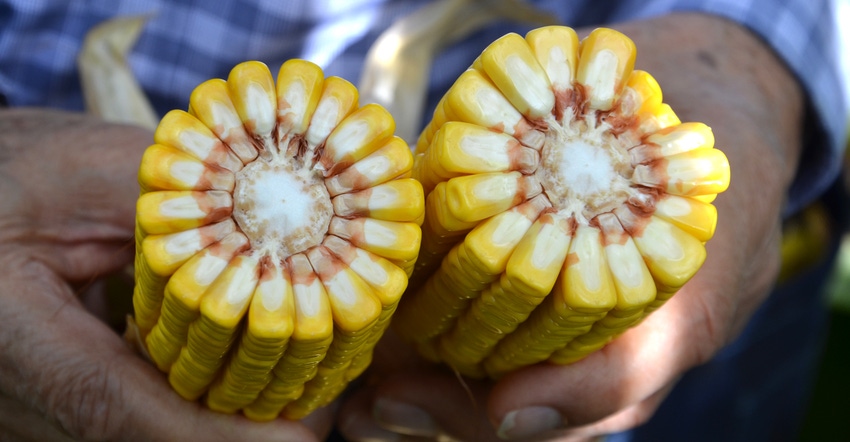
Many people are reporting small corn kernel size in 2019. Where extreme dry weather stress hit during grain fill, that likely is to blame for small kernels. However, based on what Dave Nanda saw in the Corn Watch ’19 field, he’s not ready to make that into a blanket statement.
“Corn kernel size is affected by many factors,” Nanda begins. He is director of genetics for Seed Genetics-Direct, Jeffersonville, Ohio. Seed Genetics-Direct sponsors Corn Watch ’19.
“Those factors certainly include weather during grain fill, but they also include possible nutrient deficiencies and many other things,” Nanda says. “Hybrid genetics is perhaps one of the biggest factors of all. Some hybrids will inherently produce larger, deeper kernels than others, no matter what year it is. That doesn’t always mean hybrids which tend to produce large kernels yield more. You must factor in other traits tied to genetics which determine total number of kernels produced per ear.”
Those traits include number of rows of kernels around an ear. While this can be impacted by extreme stress, number of rows of kernels per ear is strongly tied to genetics, Nanda says. Length of the average ear, which determines total number of kernels per ear, also impacts total number of kernels produced per an average plant.
Classic example
The two hybrids planted side by side in 24-row blocks across the Corn Watch ’19 field prove Nanda’s point. He checked several ears of each hybrid before harvest and found the same thing each time.
“Ears of one hybrid had very deep, very large kernels,” he explains. “However, kernels on the other hybrid were average in size. The larger kernels were perhaps 50% larger than smaller kernels from the second hybrid.”
However, ears of the second hybrid tended to have six to eight more kernels per row than the hybrid with deeper kernels. Both averaged 16 rows of kernels per ear.
Kernel size comes into play when figuring how many kernels it takes to fill a bushel basket, Nanda says. That’s where the division factor in yield formulas comes in. Older hybrids tended to have smaller kernels, and for a long time, the average division factor was 90. For modern hybrids, 75 to 85 may be more accurate division factors if you’re attempting to estimate yield in a normal year, according to Bob Nielsen, Purdue University Extension corn specialist.
Here are two examples, based on the two hybrids in the Corn Watch ’19 field. Yield estimates were made after checking several ears at random and determining stand counts to be 30,000 plants per acre for each hybrid. The formula is number of ears per 1/1,000 acre times number of rows of kernels times number of kernels per row, divided by the division factor.
Example 1: (large kernel hybrid) 30 times 16 times 36 equals 17,280, divided by 90 equals 192 bushels per acre; divided by 85 equals 203.3 bushels; divided by 80 equals 216 bushels; divided by 75 equals 230.4 bushels
Example 2: (small kernel hybrid) 30 times 16 times 42 equals 20,160, divided by 100 equals 201.6 bushels per acre; divided by 95 equals 212.3 bushels; divided by 90 equals 224 bushels; divided by 85 equals 231.1 bushels
The yield monitor will reveal the true results.
About the Author(s)
You May Also Like




